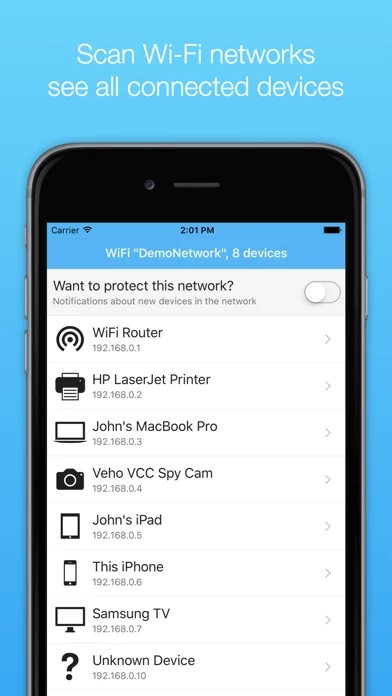
How to Delete WiFi Guard
Published by Dzmitry PlashchynskiWe have made it super easy to delete WiFi Guard - Scan devices and protect your Wi-Fi from intruders account and/or app.
Table of Contents:
Guide to Delete WiFi Guard - Scan devices and protect your Wi-Fi from intruders
Things to note before removing WiFi Guard:
- The developer of WiFi Guard is Dzmitry Plashchynski and all inquiries must go to them.
- Under the GDPR, Residents of the European Union and United Kingdom have a "right to erasure" and can request any developer like Dzmitry Plashchynski holding their data to delete it. The law mandates that Dzmitry Plashchynski must comply within a month.
- American residents (California only - you can claim to reside here) are empowered by the CCPA to request that Dzmitry Plashchynski delete any data it has on you or risk incurring a fine (upto 7.5k usd).
- If you have an active subscription, it is recommended you unsubscribe before deleting your account or the app.
How to delete WiFi Guard account:
Generally, here are your options if you need your account deleted:
Option 1: Reach out to WiFi Guard via Justuseapp. Get all Contact details →
Option 2: Visit the WiFi Guard website directly Here →
Option 3: Contact WiFi Guard Support/ Customer Service:
- 100% Contact Match
- Developer: Alexander Zaytsev
- E-Mail: [email protected]
- Website: Visit WiFi Guard Website
How to Delete WiFi Guard - Scan devices and protect your Wi-Fi from intruders from your iPhone or Android.
Delete WiFi Guard - Scan devices and protect your Wi-Fi from intruders from iPhone.
To delete WiFi Guard from your iPhone, Follow these steps:
- On your homescreen, Tap and hold WiFi Guard - Scan devices and protect your Wi-Fi from intruders until it starts shaking.
- Once it starts to shake, you'll see an X Mark at the top of the app icon.
- Click on that X to delete the WiFi Guard - Scan devices and protect your Wi-Fi from intruders app from your phone.
Method 2:
Go to Settings and click on General then click on "iPhone Storage". You will then scroll down to see the list of all the apps installed on your iPhone. Tap on the app you want to uninstall and delete the app.
For iOS 11 and above:
Go into your Settings and click on "General" and then click on iPhone Storage. You will see the option "Offload Unused Apps". Right next to it is the "Enable" option. Click on the "Enable" option and this will offload the apps that you don't use.
Delete WiFi Guard - Scan devices and protect your Wi-Fi from intruders from Android
- First open the Google Play app, then press the hamburger menu icon on the top left corner.
- After doing these, go to "My Apps and Games" option, then go to the "Installed" option.
- You'll see a list of all your installed apps on your phone.
- Now choose WiFi Guard - Scan devices and protect your Wi-Fi from intruders, then click on "uninstall".
- Also you can specifically search for the app you want to uninstall by searching for that app in the search bar then select and uninstall.
Have a Problem with WiFi Guard - Scan devices and protect your Wi-Fi from intruders? Report Issue
Leave a comment:
What is WiFi Guard - Scan devices and protect your Wi-Fi from intruders?
Laggy Wi-Fi? Maybe your neighbor has hacked your password and quietly use it. With WiFi Guard app you will be able to prevent unauthorized access to your network. This application scans your Wi-Fi and detects all connected devices. Most of the discovered devices have readable names, like “HP Printer” or “John's iPhone”. Thus, you can easily identify if any of them are foreign. So you’ll know when it’s time to change your Wi-Fi password or talk to your neighbor :) WiFi Guard can scan your networks automatically and send notifications about new devices. This application is designed for both casual and professional use. It's a great tool for system administrators to monitor and diagnose Wi-Fi networks. Capabilities: ● Discovers all devices connected to your Wi-Fi network ● Automatic Wake-on-LAN to “wake up” sleeping devices ● Provides detailed technical information about every device, particularly: ● IP and MAC addresses ● Device’s name from network name services (UPnP, NetBIOS, Bonjou...




















